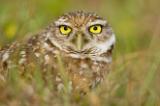 © Steve Vaughn/Panoramic Images (Florida Title Image Large)
© Steve Vaughn/Panoramic Images (Florida Title Image Large)

Dry Prairie in Florida
Dry prairie is a natural plant community of low shrubs and grasses occupying vast, level expanses of land. This community type is unique to Florida and is restricted to three major areas north and west of Lake Okeechobee. Dry prairies are notable for their lack of trees, although they are otherwise similar to pine flatwoods communities. Research suggests there is a combination of factors inhibiting the growth of pine trees. One reason is that natural fires occur more frequently in dry prairies. This community typically occupies large stretches of land that are not dissected by streams or by other features that might inhibit the spread of fire. In addition, dry prairies hold water after a heavy summer rainfall for a longer time than do pine flatwoods. These periods of prolonged flooding may also inhibit the growth of pine trees.
The open dry prairie is essential habitat for several rare animals, particularly Florida burrowing owls (Athene cunicularia floridana), Federally threatened crested caracaras (Caracara cheriway), and endangered grasshopper sparrows (Ammodramus savannarum floridanus). The grasshopper sparrow, in particular, is restricted to this habitat and the conversion of large prairies to sod farms and pastures has been the main factor in the decline of this species.
The historic range of dry prairie is difficult to determine accurately. Recent interpretations of maps from the mid-1800s suggest this landscape probably covered about 1.2 million acres in Florida. Development and conversion of prairies to pasture and agricultural lands during the 20th century greatly reduced the extent of this ecosystem. On the remaining natural lands, fire exclusion and alterations to natural drainages also pose threats. Large, high quality examples of this ecosystem are now mainly restricted to a few publicly owned lands, particularly Kissimmee Prairie Preserve State Park, Three Lakes Wildlife Management Area, and Myakka River State Park.
Florida Fish and Wildlife Conservation Commission Wildlife Legacy Initiative
Florida's Wildlife Legacy Initiative is our opportunity to conserve Florida’s wildlife and their habitats. The goal is to prevent wildlife from becoming endangered before they become more rare and costly to protect.
U.S. Fish and Wildlife Service Description of Dry Prairie
Learn more about dry prairie through the U.S. Fish and Wildlife Service Website.





